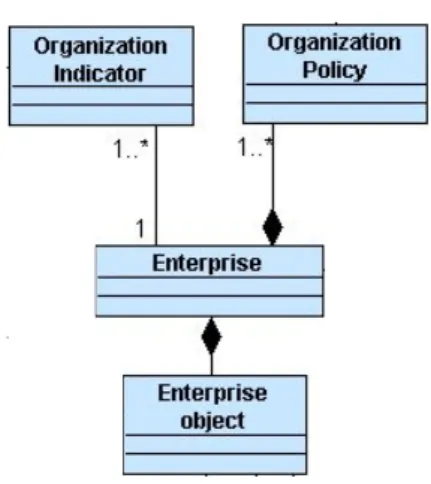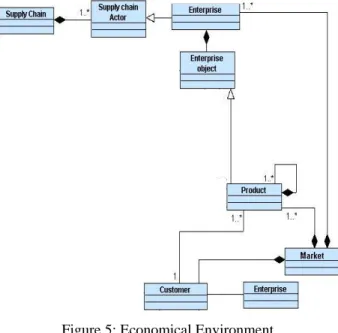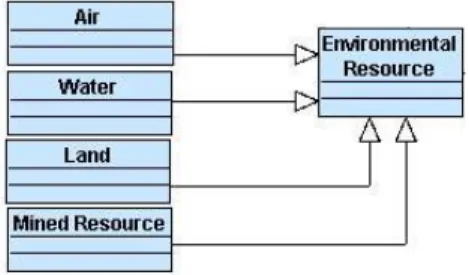HAL Id: hal-00728579
https://hal.archives-ouvertes.fr/hal-00728579
Submitted on 30 Aug 2012HAL is a multi-disciplinary open access archive for the deposit and dissemination of sci-entific research documents, whether they are pub-lished or not. The documents may come from teaching and research institutions in France or abroad, or from public or private research centers.
L’archive ouverte pluridisciplinaire HAL, est destinée au dépôt et à la diffusion de documents scientifiques de niveau recherche, publiés ou non, émanant des établissements d’enseignement et de recherche français ou étrangers, des laboratoires publics ou privés.
An enterprise meta model for the assessment and
improvement of sustainability and mass customization
performance
Khaled Medini, Catherine Da-Cunha, Alain Bernard
To cite this version:
Khaled Medini, Catherine Da-Cunha, Alain Bernard. An enterprise meta model for the assessment and improvement of sustainability and mass customization performance. 9th International Conference on Modeling, Optimization & SIMulation, Jun 2012, Bordeaux, France. �hal-00728579�
“Performance, interoperability and safety for sustainable development”
AN ENTERPRISE META MODEL FOR THE ASSESSMENT AND
IMPROVEMENT OF SUSTAINABILITY AND MASS CUSTOMIZATION
PERFORMANCE
K. MEDINI, C. DA CUNHA, A. BERNARD
LUNAM Université, Ecole Centrale de Nantes IRCCyN UMR CNRS 6597
1 Rue de la Noë, Nantes, France
{khaled.medini, catherine.da-cunha, alain.bernard}@irccyn.ec-nantes.fr
ABSTRACT: In a mass customization and sustainability context, enterprises are endeavouring to provide customized products, gain new markets while enhancing social, economic and environmental sustainability. Moreover the performance of the firm needs to be measured in order to control the progress towards the above mentioned goals. At this point, all performance inductors have to be considered in order to ensure a complete assessment. In this paper, a meta-model of the enterprise that takes into account these considerations is presented. The meta-model attempts to depict all enterprise components and factors arising from its environments in order to provide a global vision of the Sustainable Mass Customized (SMC) enterprise model which in turn will be exploited in farther steps for the assessment and performance improvement of such firms.
KEYWORDS: Enterprise meta-model, sustainability, mass customization, performance assessment.
1 INTRODUCTION
Enterprises are faced by big demand and variety of cus-tomer preferences that require the delivery of customized products with important quantities using efficient pro-duction systems. These requirements form the essence of mass customization which presents opportunities for new markets holding and improvement of firm’s competi-tiveness.
Nevertheless, additional factors emerged from govern-ments’ pressure and customer consciousness about sus-tainability issues. Such factors need to be considered in order to survive the nowadays market competition while satisfying all stakeholders. Accordingly, sustainable mass customized (SMC) enterprises gain more competi-tive advantages against traditional enterprises.
Moving towards a SMC enterprise suggests the deploy-ment of processes and resources to provide customized products, gain new markets while enhancing social, eco-nomic and environmental sustainability. Moreover, the performance of the firm needs to be measured in order to control the progress towards the SMC model. At this point, all performance inductors have to be considered in order to ensure a complete assessment.
In this paper, a meta-model of the enterprise that takes into account these considerations is presented. The meta-model attempts to depict all enterprise components (i.e. processes, etc.) and factors arising from its environments (i.e. social, economic, and ecological) in order to provide
a global vision of the SMC enterprise model which in turn will be exploited in farther steps; performance as-sessment and improvement of such firm.
The rest of the paper is organized as follows; section 2 highlights the requirements of sustainable mass custom-ized enterprise assessment which were used to build up the model components presented in section 3. Section 4 describes the SMC-E model. Research perspectives are discussed in section 5.
2 MASS CUSTOMIZATION AND SUSTAINABILITY ASSESSMENT REQUIREMENTS
Mass customization literature is quite consistent and full of case studies and theoretical analysis. Most of the stud-ies are focused on some specific enablers of mass cus-tomization. More complete views of all mass customiza-tion enablers can be found in literature surveys (Da Sil-veira, 2001; MacCarthy, 2003; Daaboul et al., 2009). In terms of assessment, different levels are distinguished; first, the evaluation of the applicability of mass customi-zation as a strategy (Daaboul et al., 2009). Second the evaluation of mass customization enablers through anal-ysis of processes and/or design customizability, for in-stance (Yang and Li, 2002; Jiao and Tseng, 2004; Wel-born, 2009), this stream involves the mechanisms of MC. Third; assessment may focus on the results of mass customization in terms of customer requirements
satis-MOSIM’12 - June 06-08, 2012 - Bordeaux - France
faction (Jiao and Tseng, 2004). Accordingly the mass customization evaluation involves stakeholders such as suppliers, customer in addition to the enterprise proc-esses and products. This suggests that a modelling of the enterprise meant to provide data for the assessment must include all the above mentioned components.
In terms of sustainability, several authors highlighted that such concept embraces different levels of the or-ganization (Labuschagne, 2004; Laine, 2005; Jayal et al., 2010). It can be concluded from the findings of the aforementioned authors and sustainability literature re-view that the levels are; product, process, and organiza-tion and supply chain. In the following examples are given to illustrate the need for these levels for each of the sustainability dimensions.
Economically speaking, the product Bill-Of-Material (BOM), production processes, suppliers cost, all impact the overall cost of the final product. For the environ-mental impact, let us take the example of resource use, this latter depends on the product material, processes use of auxiliary materials, etc. In terms of social sustainabil-ity (which involves the labour and society), the organiza-tion level (or company level) is the main driver of such dimension. This has also been pointed out by authors whose researches involve the social dimension of sus-tainability such as Jørgensen et al. (2008) and Dreyer (2009).
A consequence of this analysis is that product, process, organization and supply chain levels are inevitable for the indented meta-modelling. Moreover social, economic and ecological environments of the enterprise need to be considered, even indirectly; without being depicted as parts of the meta-modelling.
3 MODEL COMPONENTS
This section presents the components of the meta-model deducted from the previous section. For the sake of un-derstandability, the components are depicted separately in this section before presenting the complete meta-model in section 4.
UML class diagrams have been used to depict the ob-jects of the meta-model. Following indexes give short explanation of the used associations’ meanings:
: A is comprised of B.
: B type is of type A.
: A is associated to 1 or more Bs.
: B is associated to 1 or more As.
3.1 Enterprise
This sub-section involves the enterprise objects and or-ganizational level. Enterprise is depicted as a central element of the model. In (Labrousse and Bernard, 2008) enterprise objects include product, process, resource and external effect (PPRE). The current model follows the same logic except for the external effect object. This latter has been extended to depict environmental, eco-nomic and social environments constraints. In other terms, the equivalent of “External Effect” is Enterprise
Environment which strongly impacts the Organization Policy that will be described in section 3.1.1.
3.1.1 Organizational level
Figure 1: Organizational level
Being associated to the enterprise, organizational level is not a physical object. It can be perceived through organi-zation policies depicted by Organiorgani-zation Policy. This latter refers to enterprise strategies and management rules of labour, resources, investments, etc. (Fig. 1).
3.1.2 Product
Figure 2: Product
In addition to the product itself, Product model com-prises components and raw material, each of which is a product in turn. This relationship between product and
B A
B A
B A
components and raw materials is depicted by the compo-sition (Fig. 2). The Product is an Enterprise object.
3.1.3 Process
Figure 3: Process
Process, as an enterprise object, is the set of activities
involved in the production of a good. Processes range from the raw material extraction to the end of life of the product or delivery of the service (Fig. 3).
3.1.4 Resource
Figure 4: Resource
Resource is a generic enterprise object that may have
different types namely, staff, material and financial re-sources. Staff refers to Employee. Material Resource can be Raw material, Energy, Technology or Equipment.
Financial Resource refers to all money forms that
enter-prise possesses (Fig. 4).
3.2 Enterprise environment
3.2.1 Economic environment
Enterprise is a stakeholder within the supply chain; it
can also play the role of Customer.
Supply Chain consists of all processes and flows
in-volved in providing a product to the customer (Supply Chain Council, 2010).
Market is a place where Suppliers of a given product and
Customers meet to make transactions.
Economic environment is comprised of both Market and Supply Chain stakeholders where relationships differ. In
fact, in the former we speak about competitiveness be-tween enterprises, while in the latter what counts is mainly partnership and coordination between supply chain actors (Fig. 5).
Figure 5: Economical Environment
3.2.2 Social environment
Figure 6: Social Environment
Society is comprised of Individuals, Local communities
and Governments (Fig. 6). Customer is a role which can be taken by any of society components (and the prise). Society with all its components urges the enter-prise to carry out sustainable development, thus such impact is important for the SMC firm. Customer in-cludes also the requirements that have to be fulfilled by the customized product. These requirements involve sustainability (i.e. emissions thresholds, cost, etc) and mass customization as well (i.e. required speed, size, etc).
MOSIM’12 - June 06-08, 2012 - Bordeaux - France
3.2.3 Ecological environment
Ecological environment is considered as a set of
re-sources namely Mined, Air, Land and Water rere-sources (Fig. 7). This classification is inspired from the Life Cy-cle Assessment method (CML et al., 2001; Rebitzer et
al., 2004) where environmental impact is often assigned
to four Areas of Protection (AoP) namely; Air Re-sources, Land ReRe-sources, Water Resources and Mined Resources (Mangena and Brent, 2006).
Figure 7: Ecological Environment
3.3 Indicators
Figure 8: Indicator
Indicators fall under the standardized models category used to evaluate sustainability (Todorov and Marinova, 2010) but they are also a very used technique in the field of mass customization assessment - even if this latter is not well established. Accordingly, an indicator allows measuring the performance of customization and / or sustainability. Indicator as a component of the model, measures the sustainability and/or mass customization performance for a given aspect (i.e. process customiza-bility, emissions to ecological environment, etc).
Indica-tor depends on Enterprise Environment that includes Economic, Social and Ecological ones. It depicts the
impact of these latter on the Enterprise and vice-versa (Medini et al. 2011). Indicator is of different types, it can be associated to Organizational level (i.e. labour management) or enterprise objects including, Product (i.e. material cost, etc.), Process (i.e. process customiza-bility, etc.) and Resource (i.e. energy consumption, etc.) (Fig. 8).
4 META MODEL OVERALL SHAPE
The meta-model is depicted in Figure 9. It groups all the above mentioned components to provide a complete vi-sion that spans enterprise components and stakeholders. To put together puzzles, following associations are re-quired;
Product – Resource: Characterizes the resources used to
provide a given product (that can also be a component or raw material).
Activity – Resource; Characterizes the resources used by
a given activity that is a part of a process.
Product – Process; for a given product, only a definite
set of process sequences is possible. This link defines the possible Processes and/or activities apt to perform a giv-en Product. This is particularly important during the process planning for a product variant.
Individual – Employee; Employee of the enterprise is
actually an individual in the society.
Environmental Resource – Material Resource; Material
resource is a part of environmental resources.
Customer – Product; the product functionalities have to
fulfil certain requirements of a given customer. In Figure 9, associations are represented with the con-tinuous line. The class Enterprise is depicted twice for the sake of clarity, it depicts the same object.
Social, Economic and Ecological environments fall all
under the Enterprise Environment category. The impact of these environments is taken into account by introduc-ing the Indicator object whose calculation uses informa-tion about the Enterprise Environment (i.e. characteriza-tion of the emissions, purchasing price, customer re-quirements, investments in society, etc.). The dependen-cies of Indicator and Organization Policy (mentioned before) on Enterprise Environment are depicted by the arrow broken lines.
5 CONCLUSIONS
In this paper a meta-model of the SMC-E has been built upon the requirements of a complete assessment of sus-tainability and mass customization performance. It was concluded that different components inherent to the en-terprise and external stakeholders (i.e. Supply chain ac-tors, Enterprise Environment) need all to be modelled. Each of these components has been described separately. Together, the meta-model components define the scope of an effective SMC-E assessment allowing the analysis and improvement of sustainability performance of a mass customization solution space. The specifications herein established provide the basis of following tasks:
- Development of sustainability and mass
cus-tomized assessment model starting from in-stances of the present meta-model.
- Development of simulation models by adapting
the proposed meta-model and creating instances for the simulation.
- Analysis and improvement of sustainability per-formance of mass customized solutions.
- Analysis of the links between mass
customiza-tion and sustainability.
Nevertheless, the meta-model validation needs to con-sider several case studies by at least having interviews with or questionnaires to be filled by managers.
ACKNOWLEDGMENTS
This work has been partly funded by the European Commission through S-MC-S (Sustainable Mass Customization - Mass Customization for Sustainability) project (Grant Agreement No: FoF.NMP.2010-2
260090 - S-MC-S).
MOSIM’12 - June 06-08, 2012 - Bordeaux - France
REFERENCES
Centre of Environmental Science (CML) and University of Technology (TUD/TB), Fuels and Raw Material Bureau (Bureau B&G), University of Amesterdam (UVA), IVAM-Environmental Research (IVAM-ER), Netherlands Organization for Applied Scientific Research (TNO), 2001. Life Cycle Assessment: An
operational guide to the ISO standards - Part 1: LCA in Perspective [online]. Available from:
http://cml.leiden.edu/research/industrialecology/resea rchprojects/finished /new-dutch-lca-guide.html. Daaboul, J., A. Bernard and F. Laroche, 2009.
Implementing Mass Customization: Literature
Review. 5thWorld Conference on Mass
Customization and Personalization, Helsinki,
Finlande.
Da Silveira, G., Borestein, D., Fogliatto, F.S., 2001. Mass customisation literature review and research directions. International Journal of Production
Economics, 72(1), p. 1-13.
Dreyer, L., 2009. Inclusion of Social Aspects in Life
Cycle Assessment of Products. PhD Thesis,
Technical University of Denmark, Danemark.
Jayal, A. D., F. Badurdeen, O.W. Dillon and I.S. Jawahir, 2010. Sustainable manufacturing: Modeling and optimization challenges at the product, process and system levels. CIRP Journal of Manufacturing
Science and Technology, Volume 2, Issue 3, 2010, p.
144-152.
Jiao, J. and M. M. Tseng, 2004. Customizability analysis in design for mass customization. Computer-Aided
Design, 36(8), p. 745-757.
Jørgensen, A., A. Le-Boqc, L. Nazakina and M. Hauschild, 2008. Methodologies for social life cycle assessment. International Journal of Life Cycle
Assessment, 13(2), p. 96-103.
Labrousse M., A. Bernard, 2008. FBS-PPRE, an Enterprise Based Knowledge Life Cycle Model,
Methods and Tools for Effective Knowledge Life-Cycle-Management, p. 285-305.
Labuschagne C., A. C. Brent and R. P. G. van Erck, 2004. Assessing the sustainability performances of industries, Journal of Cleaner Production, 13(4), p. 373-385.
Laine, 2005. Meanings of the term ‘sustainable development’ in Finnish corporate disclosures.
Accounting Forum, 29(4), p. 395-413.
MacCarthy, B., 2003. Fundamental modes of operation for mass customization. International Journal of
Production Economics, 85(3), p. 289-304.
Medini, K., C. Da Cunha and A. Bernard, 2011. Towards an Integrated Mass Customization and Sustainability Assessment Framework. The 2011 World Conference
on Mass Customization, Personalization, and Co-Creation, San Francisco, USA.
Mangena S. and A. Brent, 2006. Application of a Life Cycle Impact Assessment framework to evaluate and compare environmental performances with economic values of supplied coal products. Journal of Cleaner
Production, 14(12-13), p. 1071-184.
Rebitzer, G., T. Ekvall, R. Frischknecht, D. Hunkeler, G. Norris, T. Rydberg, W-P. Schmidt, S. Suh, B. P. Weidema and D. W. Pennington, 2004. Life cycle assessment part 1: framework, goal and scope definition, inventory analysis, and applications.
Environment international, 30(5), p. 701-720.
Supply Chain Council, 2010. Supply Chain Operations
Reference Model, Version 10.0 Business strategies for sustainable development, Supply Chain Council,
USA.
Todorov, V. and D. Marinova, 2011. Modelling sustainability. Mathematics and Computers in
Simulation, 81(7), p. 1397-1408.
Welborn, C., 2009. Customization Index : Evaluating the Flexibility of Operations in a Mass Customization Environment. The IUP Journal of Operations
Management, 8 (2), p. 6-13.
Yang, S.L. and T. F. Li, 2002. Agility evaluation of mass customization product manufacturing. Journal of



